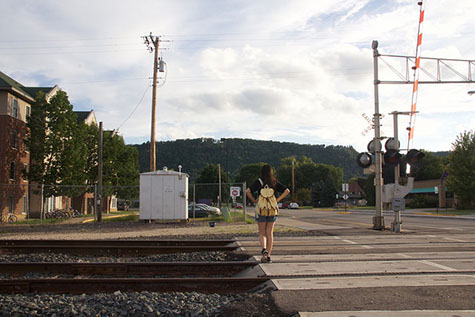
Sara Tiradossi / Winonan
About every three hours, a person or vehicle is hit by a train, according to the organization Operation Lifesaver.
But volunteers in the organization, like Jeanine Black, believe precautions can end this.
Black said each state has its own state organization to improve public safety and educate people, so when they are near or on railroad property—such as in Winona—they make safe decisions.
Operation Lifesaver began as a public awareness campaign in 1972. It is a nonprofit organization with a nationwide network of authorized volunteers who work to educate the public about rail safety, according to the organization.
Its mission is to reduce collisions, deaths and injuries at highway rail crossings and on railroad property.
Black said her role as a volunteer is important in Winona, where there have been several accidents on railroad tracks, like the accident that killed Winona State University student veteran Derek Bute in January.
Black said she wants to raise awareness about prevention techniques starting with little kids and parents.
“When I go into a school to educate on railroad safety, I provide the principal with a note for childrens’ parents to send at home,” Black said. “The parents should be informed as well.”
Black said she would like to see more outreach and advancement at Winona State, for students on all types of safety, including safety around railroads.
“Education is key. People should have a discussion about safety information to help keep each other safe,” Black said. “Because I have become an authorized volunteer, I would love to host more presentations and events about railroad safety on campus and informative talks to get the message out.”
Operation Lifesaver program also offers free rail safety programs in school classrooms, to driver education students, community service and civic groups, professional bus, truck and emergency first responder drivers and others.
According to Black, Operation Lifesaver wants to make students aware of their surroundings and make sure they can see and hear when they cross tracks at designated crossings.
“Talking with friends and family members about making safe decisions near railroad property can help to save a life,” Black said. “Anytime you see railroad tracks, expect a train. Freight trains do not run on set schedules. Trains can run on any track.”
Operation Lifesaver states a typical freight train traveling at 55 mph can take a mile or more to stop; that is equal to 18 football fields. A light train rail takes about 600 feet to stop or, the length of two football fields.
“The train takes a long time to stop because it is going very fast. It’s something that people don’t think of,” Black said.
Black added that citizens of Winona should review the organization’s safety tips whenever their route takes them near or across train tracks.
According to the organization’s tips, the only safe place to cross is at a designated public crossing with either a railroad crossing sign, flashing red lights or a gate. Also, an approaching train may be closer and moving faster than it appears.
“People shouldn’t take shortcuts. There is an optical illusion when people look and see a train coming. Part of it is because it’s so big; it looks like it’s going slower. They misjudge that distance and speed,” Black said.
Operation Lifesaver also wants to inform the public that railroad tracks, trestles, yards and equipment are private property and trespassers are subject to arrest and fine.
“The railroad trucks are not run by Winona State. They are private railroad property, so people walking along the railroad tracks can be ticketed or fined and beyond the green crossing, they are illegally trespassing,” Black said.
Above all else, Black encourages a little patience at railroad crossings.
“Whether you’re walking, biking or driving, don’t try to beat the train. You might have to stop for five or 10 minutes, 15 maximum,” Black said. “It’s not worth risking your life and the life of others.”







































